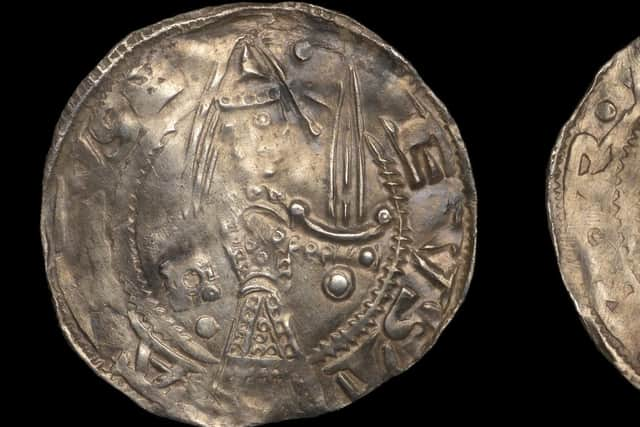12th-century coin found by amateur Leeds metal detectorist near Pickering sells for nearly £30,000
Leeds man Rob Brown has said he will bulk up his pension pot after his find of a lifetime near Pickering was sold to a UK bidder today.
The coin was minted in the name of Baron Eustace Fitzjohn, a 'lord of the north' who was one of the most powerful men of the age and was sold today for £29,760 (£24,000 hammer price).
Advertisement
Hide AdAdvertisement
Hide AdHe found the silver coin just two inches beneath the surface in August.


Mr Brown, who is in his 50s, said: “The auction felt quite surreal and it seemed to go so fast. I was amazed by all the interest from around the world with bidding from the USA, Brazil and the UK.
"It was very exciting; selling for much more than I expected.
"I am planning to add the money to my pension pot, and continue to carry on metal-detecting as I would love to find another one!”
Advertisement
Hide AdAdvertisement
Hide AdBefore the online auction by Dix Noonan Webb, the coin was given an estimated value of £15,000.
Nigel Mills, antiquities expert at auction house, said: “This is a tremendous result of £24,000 (hammer price), it exceeded all of our expectations.
"Bidding came from the United States and Brazil but with two UK buyers fighting it out it at the end the Eustace stays here.”
The coin was manufactured in York and is one of only 20 surviving examples with the Baron's design.
Advertisement
Hide AdAdvertisement
Hide AdThe inscription on the coin reads 'Eustacius' and there is a depiction of a knight bearing a sword.
Baron Fitzjohn was Lord of Malton and Knaresborough under King Henry I, and acquired wealth and power despite humble beginnings.
He was involved in a period of English history known as The Anarchy, when Henry I's daughter Empress Matilda and her cousin Stephen de Blois contested the Crown.
Mr Brown, who has been detecting for eight years, last month said: “I was with a friend and when we found the coin, we weren’t sure if it was Saxon or Viking, so we put a picture on a Facebook page devoted to milled and hammered coins - lots of people were reacting and were very excited and many knew instantly what it was."
Advertisement
Hide AdAdvertisement
Hide AdIn 1138, Baron Eustace Fitzjohn lost the custody of Bamburgh Castle in Northumberland to Stephen and decided to join forces with David I of Scotland, fighting with him against Stephen at the Battle of the Standard that year. In July 1157, he was killed in Flintshire after being ambushed by the Welsh army.
Dix Noonan Webb's artefacts and antiquities expert Nigel Mills then added: “Baron Eustace Fitzjohn was a Justician (chief minister of the monarch) of the north and became a great monastic patron. He was to some extent, the Alan Sugar of his day - coming from a humble background but achieving great wealth and prominence.
"As it was a period of Civil War, Baron Fitzjohn had the authority to have coins struck in York which were primarily for local use.”
Baron Fitzjohn's main seat was at Malton Castle, and through his second marriage he acquired more land and property at Bridlington, Aldborough, Tickhill, and Knaresborough, the latter as a tenant of King Henry I.
Advertisement
Hide AdAdvertisement
Hide AdIn July, another coin minted in York during The Anarchy was sold for £17,000 after being discovered in a Yorkshire field in March. It was produced for another northern lord, Robert de Stuteville, who also served as custodian of Knaresborough Castle. Eustace Fitzjohn's son William married into the de Stuteville family.
As the competing claims to the throne were disputed at the time, barons were allowed to have their own coins minted in lieu of royal authority.